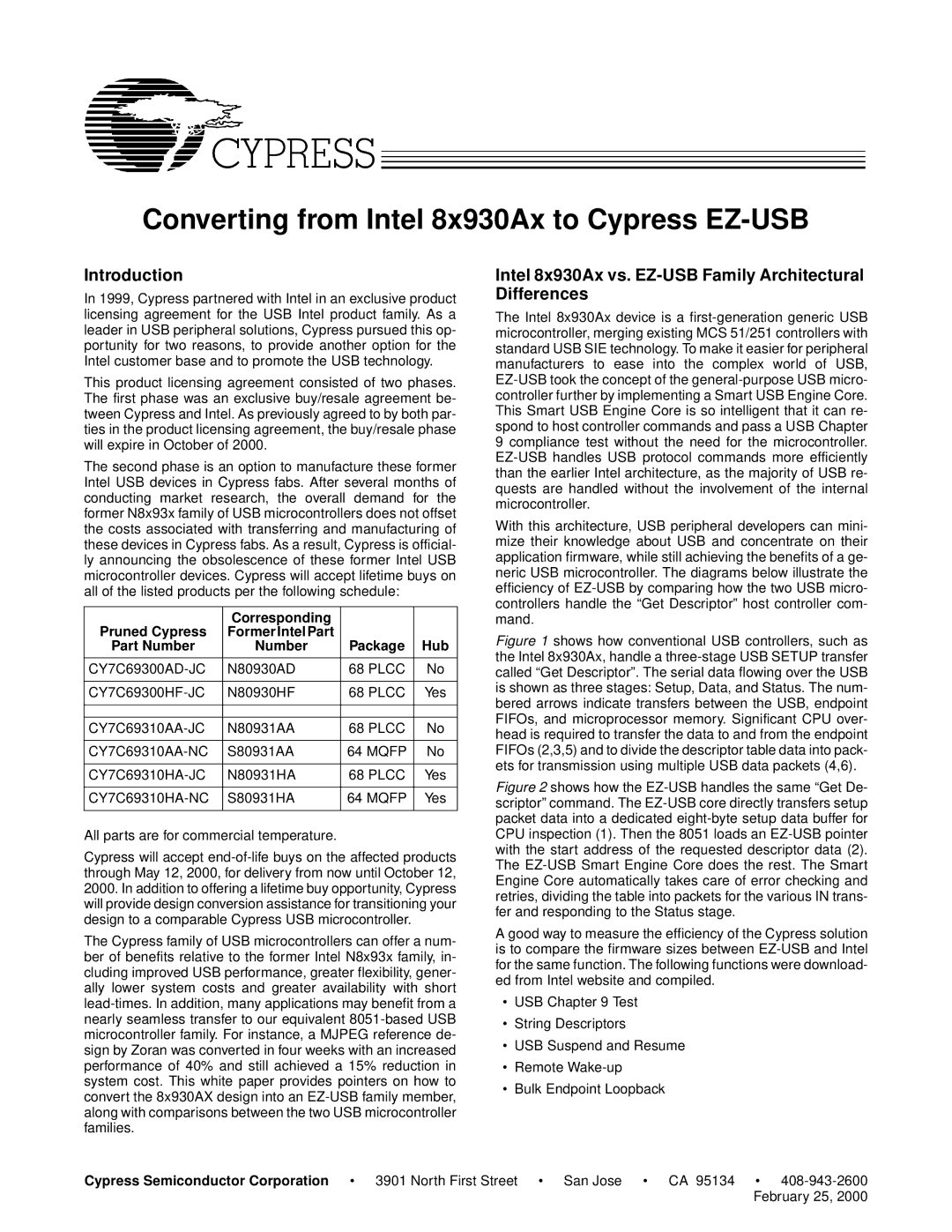Introduction
In 1999, Cypress partnered with Intel in an exclusive product licensing agreement for the USB Intel product family. As a leader in USB peripheral solutions, Cypress pursued this op- portunity for two reasons, to provide another option for the Intel customer base and to promote the USB technology.
This product licensing agreement consisted of two phases. The first phase was an exclusive buy/resale agreement be- tween Cypress and Intel. As previously agreed to by both par- ties in the product licensing agreement, the buy/resale phase will expire in October of 2000.
The second phase is an option to manufacture these former Intel USB devices in Cypress fabs. After several months of conducting market research, the overall demand for the former N8x93x family of USB microcontrollers does not offset the costs associated with transferring and manufacturing of these devices in Cypress fabs. As a result, Cypress is official- ly announcing the obsolescence of these former Intel USB microcontroller devices. Cypress will accept lifetime buys on all of the listed products per the following schedule:
| Corresponding | | |
Pruned Cypress | Former Intel Part | | |
Part Number | Number | Package | Hub |
| | | |
CY7C69300AD-JC | N80930AD | 68 PLCC | No |
| | | |
CY7C69300HF-JC | N80930HF | 68 PLCC | Yes |
| | | |
| | | |
CY7C69310AA-JC | N80931AA | 68 PLCC | No |
| | | |
CY7C69310AA-NC | S80931AA | 64 MQFP | No |
| | | |
CY7C69310HA-JC | N80931HA | 68 PLCC | Yes |
| | | |
CY7C69310HA-NC | S80931HA | 64 MQFP | Yes |
| | | |
All parts are for commercial temperature.
Cypress will accept end-of-life buys on the affected products through May 12, 2000, for delivery from now until October 12, 2000. In addition to offering a lifetime buy opportunity, Cypress will provide design conversion assistance for transitioning your design to a comparable Cypress USB microcontroller.
The Cypress family of USB microcontrollers can offer a num- ber of benefits relative to the former Intel N8x93x family, in- cluding improved USB performance, greater flexibility, gener- ally lower system costs and greater availability with short lead-times. In addition, many applications may benefit from a nearly seamless transfer to our equivalent 8051-based USB microcontroller family. For instance, a MJPEG reference de- sign by Zoran was converted in four weeks with an increased performance of 40% and still achieved a 15% reduction in system cost. This white paper provides pointers on how to convert the 8x930AX design into an EZ-USB family member, along with comparisons between the two USB microcontroller families.
Intel 8x930Ax vs. EZ-USB Family Architectural Differences
The Intel 8x930Ax device is a first-generation generic USB microcontroller, merging existing MCS 51/251 controllers with standard USB SIE technology. To make it easier for peripheral manufacturers to ease into the complex world of USB, EZ-USB took the concept of the general-purpose USB micro- controller further by implementing a Smart USB Engine Core. This Smart USB Engine Core is so intelligent that it can re- spond to host controller commands and pass a USB Chapter 9 compliance test without the need for the microcontroller. EZ-USB handles USB protocol commands more efficiently than the earlier Intel architecture, as the majority of USB re- quests are handled without the involvement of the internal microcontroller.
With this architecture, USB peripheral developers can mini- mize their knowledge about USB and concentrate on their application firmware, while still achieving the benefits of a ge- neric USB microcontroller. The diagrams below illustrate the efficiency of EZ-USB by comparing how the two USB micro- controllers handle the “Get Descriptor” host controller com- mand.
Figure 1 shows how conventional USB controllers, such as the Intel 8x930Ax, handle a three-stage USB SETUP transfer called “Get Descriptor”. The serial data flowing over the USB is shown as three stages: Setup, Data, and Status. The num- bered arrows indicate transfers between the USB, endpoint FIFOs, and microprocessor memory. Significant CPU over- head is required to transfer the data to and from the endpoint FIFOs (2,3,5) and to divide the descriptor table data into pack- ets for transmission using multiple USB data packets (4,6).
Figure 2 shows how the EZ-USB handles the same “Get De- scriptor” command. The EZ-USB core directly transfers setup packet data into a dedicated eight-byte setup data buffer for CPU inspection (1). Then the 8051 loads an EZ-USB pointer with the start address of the requested descriptor data (2). The EZ-USB Smart Engine Core does the rest. The Smart Engine Core automatically takes care of error checking and retries, dividing the table into packets for the various IN trans- fer and responding to the Status stage.
A good way to measure the efficiency of the Cypress solution is to compare the firmware sizes between EZ-USB and Intel for the same function. The following functions were download- ed from Intel website and compiled.
•USB Chapter 9 Test
•String Descriptors
•USB Suspend and Resume
•Remote Wake-up
•Bulk Endpoint Loopback

